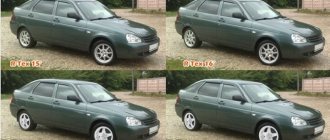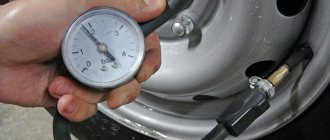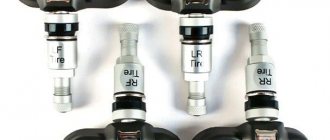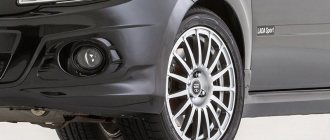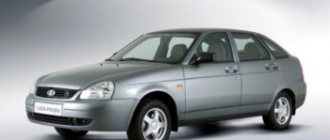How often to measure to kill rubber
Please note that pressure may change due to changes in ambient temperature.
Moreover, the process occurs equally in winter and summer. The main rule when checking is to measure it before driving, before the tires get hot. After a short trip, the wheels become very hot and the performance differs significantly from the real ones. Measurements should be taken not only after tire wear has become noticeable. The manufacturer recommends checking the inflation when you feel that the car is behaving differently.
For example, it began to throw to the sides, uncertainly when entering turns. In any operating book you will find information that a check must be carried out if temperature changes reach 10-15 degrees.
As a rule, these are the spring/autumn seasons, be careful this is a time of temperature fluctuations.
In what units is tire inflation measured?
The difference in the degree of tire inflation depends on the basic parameters of the car:
- Gross vehicle weight with or without loading. With a loaded car, the wheels are pushed through more than with an empty trunk and driver.
- Cylinder dimensions. Tire cavity capacity is of primary importance. For example, the pressure in winter tires R13 VAZ 2106 and R 16 on Vesta will differ by an average of 0.4 BAR.
- Speed index. At high speeds and driving on smooth asphalt, an improved free run is required. At the same time, for off-road modifications – this is not necessary.
In the CIS countries, the most common technical atmospheres are At, and pascals (kPa) or the metric system. However, in Europe and the USA, the units of measurement are their own (PSI, BAR). Due to the widespread use of imported rubber in Russia, the buyer needs to know exactly the ratio and compatibility of pressure gauge designations:
- 1 kg/cm²=98 kPa;
- 1 BAR= 100kPa;
- 1PSI= 6.9 kPa.
Low profile tire pressure
This parameter, ignored by novice car enthusiasts, is very important when operating cars with any tires, and especially with low-profile ones. The required tire pressure is always indicated by the vehicle manufacturer in the operating instructions and in an accessible place on the body, for the Lada Vesta - on the B pillar on the driver's side.
- Low profile tires require increased attention to pressure, as insufficient pressure will make the wheels and suspension even more vulnerable to potholes and rocks on the road.
- As many years of experience have shown, the pressure in low-profile tires must be maintained 15% higher than that specified by the manufacturer for wheels of the recommended size.
Winter fit?
Our winter marathon demonstrated good preparation of the cars for the Russian winter, but we cannot do without reservations.
Ford Focus
— the most driving of the quartet, including on slippery surfaces. It swallows even serious potholes without problems, without annoying breakdowns. The engine easily tolerates heavy loads and high speeds. But on a snow-covered highway, the Focus instantly becomes covered in snow, and the modest ground clearance forces you to be especially vigilant on uneven roads.
On a broken Creta
behaved excellently and, unlike Ford, did not give cause for concern in a rut. But it lacks stability on slippery roads, which is especially noticeable compared to other cars. A glitch in the tire pressure monitoring system also alerted me. However, the most serious complaint arose after oil analysis. The Creta does not tolerate frequent cold starts and constant high revs. If you want the engine to last for a long time, do not load it too much, use medium speeds and change the oil on time.
Even in comparison with the Hyundai Creta SUV, the regular Vesta SW
- a real SUV. The ground clearance is higher, the energy intensity of the suspension is higher. But it is necessary to understand the voltage in the network. Devices are not allowed to turn off even at the highest speeds! The same goes for the Cross version.
Vesta SW Cross
annoying with excessive body rocking, and low-profile tires reduce the effect of the impenetrable chassis - hernias, a punctured tire and a jammed wheel are witnesses to this. But in terms of “cleanliness”, both Ladas are head and shoulders above their famous rivals: the fact that after several hours of a snow-covered road the feed remains clean is an invaluable quality. And the engines of both Wests turned out to be resistant to heavy loads. It was their engines that showed the least wear - even after cold starts. Excellent result!
Tire pressure Lada Vesta
If you don’t know what pressure is in the Lada Vesta tires, then this article will answer your question.
Please note that it is necessary to check tire pressure quite often, as this directly affects driving safety. Manufacturers also set standards for each specific car so that the driver has something to focus on.
The Lada Vesta instruction manual contains the following values:
| Vehicle modification and execution | Tire size with load capacity and speed indexes* | Wheel size | Air pressure in tires front/rear, MPa (kgf/cm2) | |||
| Rim width (inches) | Rim offset (et)**, mm | Partial load*** | Full load**** | |||
| Installed by the manufacturer | ||||||
| "sedan" version | All modifications | 185/65r15 88h 195/55r16 91h | 6j | 50 | 0,21/0,21 (2,1/2,1) | 0,2/0,22 (2,1/2,1) |
| Allowed to be installed during operation | ||||||
| "sedan" version | All modifications | 185/65R15 88T, H 195/55R16 87.91T, H | 5J, 5½J, 6J 5½J, 6J, | 50 | 0,21/0,21 (2,1/2,1) | 0,21/0,21 (2,1/2,1) |
New Lada: Is it necessary and how to close the Vesta radiator in winter: reasoning and ideas
* Speed indices: T - up to 190 km/h, H - up to 210 km/h. Load capacity indices: 88–560 kg; 91–615 kg. **Rim offset (ET) is the distance from the mating plane of the disc to the middle of the rim. *** Partial load – no more than 3 adults in the car without cargo in the trunk.
**** Full load – more than 3 adults or 3 adults and a load of 50 kg in the trunk.
Deviation from these recommendations will lead to dire consequences:
- The stability and controllability of your car will deteriorate;
- Fuel consumption will increase due to greater tire resistance;
- Tire wear will increase.
If you don’t want to memorize the table, then on the Lada Vesta the recommended tire pressure values are indicated on a special information plate, which is located on the B-pillar on the driver’s side. Just open the driver's door and find out the recommended tire pressure for the Lada Vesta.
If the pressure constantly drops, then it is necessary not only to pump up the tires, but to eliminate the source of the leak. First of all, you should check the spool; if it is working, then the problem is in the tires or wheels. You may have a puncture or a loose fit between the tire and the rim.
Note that the air pressure in tires is constantly changing, depending on the temperature of the air inside the tire. At low temperatures, air compresses and pressure drops; as temperature rises, pressure increases.
It is optimal to check the readings at an ambient temperature within 10-15 degrees Celsius and after a short period of inactivity. When driving, the tires warm up, so measuring the pressure immediately after a trip is incorrect.
Review of the best summer and winter tires
How many studs should there be on winter tires r16, r15, r14?
For a comfortable ride, you should have two separate sets of tires - for driving in the summer and winter. If you have a limited budget, the Sava Adapto HP MS tire will be the optimal solution for summer. Its cost will be no more than 3,800 rubles per cylinder. At the same time, it is durable and can be used even in winter.
If you have enough money, you should purchase Michelin Crossclime+ tires. Its price is slightly higher - from 4,500 rubles. The wide contact patch makes it easy to keep the car on the road in any weather conditions. The tread has many channels to drain water from the contact patch.
Goodyear Vector4Seasons tires will cost slightly less than Michelin. However, they will make the movement of the car no less comfortable. However, unlike the model discussed above, the rubber composition does not contain silicon. Which makes the protector less durable and wears out quickly.
Hankook RA33 has a bi-directional tread, so if necessary, the wheels can be easily switched sides. This model will be relatively cheap. The price will be approximately 3,500 rubles. The maximum permissible speed is 190 km/h. There are as many as 4 longitudinal grooves - they help avoid hydroplaning of the car.
Pirelli Cinturato P1 tires are the optimal solution for driving a car in the summer. The wheel can easily withstand a load of 610 kg. Therefore, this model is perfect for cars used to transport families.
Pirelli Winter Formula ICE studded tires provide a high level of comfort and safety - regardless of operating conditions. Even when driving on ice, the car stays confidently on the road.
Hankook W429 tires with steel studs allow you to move at high speed in the cold season. Thanks to the unique composition of rubber, it does not harden at low temperatures.
Nokian HKPL-9 – business class studded tires. Thanks to the unique fastening of metal dumbbells, they remain in place throughout the entire period of operation.
Gislaved Nord Frost is distinguished by its low cost (no more than 4 thousand rubles for 1 wheel) and durability. Maximum speed – 190 km/h. Using such tires, the driver will not have to worry about his safety on the road in winter.
Continental Ice Contact will cost 4,500 rubles or more. This model was introduced back in 2015. However, it is still considered relevant.
You can install any tires or wheels that fit your size on your Lada Vesta car. Installation of R14 is also allowed. However, you must first make sure that there are no compatibility gaps.
Hub hole diameter (d)
Some manufacturers produce wheels with an oversized hole diameter for the hub - this circumstance allows them to be used using special inserts - centering rings on many car models. Therefore, a larger hole diameter for the hub is an easily solvable problem, in contrast to the opposite situation, when the hole is small.
And yet, there is a common situation when bolted fastening seems sufficient to the car enthusiast, and the use of centering rings is neglected. In this case, at speeds above 100 km/h, wheel runout begins, which can be difficult to diagnose, and pointless balancing costs follow.
How many atmospheres to pump the wheels on the Lada Vesta Cross - instructions
The factory recommendation for Vesta Cross indicates from 2.2 to 2.4 “atmospheres”, this also depends on driving style. The size plays a role, considering that the manufacturer installs R17 wheels and size 205/50.
New Lada: Lada Kalina since 2004 Operation, maintenance and repair manual
Some people want a higher, wider tire, so they “play” with the inflation level as they want. But, you need to take into account all the features, what the load is, the diameter, the larger the diameter, the smaller the height.
It is generally accepted that for the Cross version the average values range from 2.2 to 2.4 atmospheres.
What non-standard sizes can be supplied?
In addition to the standard wheels listed above, you can install tires of non-standard diameter on your Lada Vesta. When choosing such solutions, you should definitely adhere to a number of recommendations:
- when using rubber with a diameter of 15 inches, the tire composition must have increased strength - since the car will have greater inertia when cornering;
- for aggressive, fast driving - wheels with a diameter of 17 inches are best suited;
- Summer tires are best equipped with wheels with a diameter of 16 inches - such wheels can be equipped with tires with a sole width of 185 to 195 mm and a profile height of 55-60 mm.
Before installing and starting to use tires of non-standard sizes, the driver should “try on” them. Often, when the wheel width or profile height increases, the tread begins to touch the plastic fender liner.
As a result, the fender liner itself may be broken, and the protector begins to quickly wear down on the plastic surface. Wheels that are too large often damage mudguards and the body.
The appearance of cracks and chips in the paintwork causes serious trouble.
Decoding tire markings
However, not everyone finds it easy to understand the large number of parameters with which tires are marked.
As a rule, when choosing tires, buyers focus only on the diameter, width of the rubber profile and height, after which the speed and load capacity index are selected.
Now let’s look at what this or that inscription on car tires means. Let's do this using the example of a tire marked 195/65 R15 91 T XL. In this case, the manufacturer and the specific model are not important, we are only interested in the marking itself.
The first number in the marking always indicates the width of the tire in millimeters. The sample in question has a diameter of 195 mm.
The next number is the tire height. 65 is the percentage of height to width. With simple steps we get approximately 127 mm (65% of 195).
Next comes the English letter R. Contrary to the opinions of many car owners, it does not mean the size, that is, the radius, of the tire, but denotes the tire manufacturing technology. R - radial cord. All types of tires for cars are produced using this technology.
Unsuitability of disks of other models of the Lada line
Wheel rims of size 185/55/R15 from the AvtoVAZ Grant, Priora and Kalina models cannot be installed on the Lada Vesta, even though at first glance they seem suitable. The diameter of the hole for the wheel hub of these cars is 58.5 mm, that is, 1.6 mm less.
But, even if this hole is bored on a lathe to the required size, the bolt pattern (PCD) of these products is 4x98, not 4x100, and 3 of the four mounting bolts will not be centered relative to the mounting holes, accordingly, the disk will not be aligned with the hub, and its rotation will be accompanied by beating.
Standard tire pressure monitoring system for Lada vesta
At the moment, this system is available - it is installed on export versions of the Lada family: Vesta, XRay, Kalina, Granta. It’s hard to say when the option will appear on Lada models intended for Russia; the fact that the option is available is encouraging. Perhaps soon the “gadgets” will be available here too.
Taking into account the equipment of export vehicles, their “tidy” is also different, because this is where information from the sensors is sent. In general, the TPMS tire pressure monitoring system is represented by four built-in sensors in the wheel valves. TPMS sensors regularly measure and send data to the dashboard, informing the driver.

